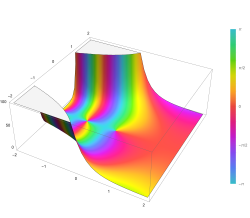Multiple gamma function

In mathematics, the multiple gamma function is a generalization of the Euler gamma function and the Barnes G-function. The double gamma function was studied by (Barnes 1901). At the end of this paper he mentioned the existence of multiple gamma functions generalizing it, and studied these further in (Barnes 1904).
Double gamma functions are closely related to the q-gamma function, and triple gamma functions are related to the elliptic gamma function.
Definition
For , let
where is the Barnes zeta function. (This differs by a constant from Barnes's original definition.)
Properties
Considered as a meromorphic function of , has no zeros. It has poles at for non-negative integers . These poles are simple unless some of them coincide. Up to multiplication by the exponential of a polynomial, is the unique meromorphic function of finite order with these zeros and poles.
In the case of the double Gamma function, the asymptotic behaviour for is known, and the leading factor is[1]
Infinite product representation
The multiple gamma function has an infinite product representation that makes it manifest that it is meromorphic, and that also makes the positions of its poles manifest. In the case of the double gamma function, this representation is [2]
where we define the -independent coefficients
where is an -th order residue at .
Another representation as a product over leads to an algorithm for numerically computing the double Gamma function.[1]
Reduction to the Barnes G-function
The double gamma function with parameters obeys the relations [2]
It is related to the Barnes G-function by
The double gamma function and conformal field theory
For and , the function
is invariant under , and obeys the relations
For , it has the integral representation
From the function , we define the double Sine function and the Upsilon function by
These functions obey the relations
plus the relations that are obtained by . For they have the integral representations
The functions and appear in correlation functions of two-dimensional conformal field theory, with the parameter being related to the central charge of the underlying Virasoro algebra.[3] In particular, the three-point function of Liouville theory is written in terms of the function .
References
- ↑ 1.0 1.1 Alexanian, Shahen; Kuznetsov, Alexey (2022-08-29). "On the Barnes double gamma function". arXiv:2208.13876v1 [math.NT].
- ↑ 2.0 2.1 Spreafico, Mauro (2009). "On the Barnes double zeta and gamma functions". Journal of Number Theory 129 (9): 2035–2063. doi:10.1016/j.jnt.2009.03.005.
- ↑ Ponsot, B. Recent progress on Liouville Field Theory (Thesis). arXiv:hep-th/0301193. Bibcode:2003PhDT.......180P.
Further reading
- Barnes, E. W. (1899), "The Genesis of the Double Gamma Functions", Proc. London Math. Soc. s1-31: 358–381, doi:10.1112/plms/s1-31.1.358, https://zenodo.org/record/1447742
- Barnes, E. W. (1899), "The Theory of the Double Gamma Function", Proceedings of the Royal Society of London 66 (424–433): 265–268, doi:10.1098/rspl.1899.0101, ISSN 0370-1662
- Barnes, E. W. (1901), "The Theory of the Double Gamma Function", Philosophical Transactions of the Royal Society of London. Series A, Containing Papers of a Mathematical or Physical Character 196 (274–286): 265–387, doi:10.1098/rsta.1901.0006, ISSN 0264-3952, Bibcode: 1901RSPTA.196..265B
- Barnes, E. W. (1904), "On the theory of the multiple gamma function", Trans. Camb. Philos. Soc. 19: 374–425
- Friedman, Eduardo; Ruijsenaars, Simon (2004), "Shintani–Barnes zeta and gamma functions", Advances in Mathematics 187 (2): 362–395, doi:10.1016/j.aim.2003.07.020, ISSN 0001-8708
- Ruijsenaars, S. N. M. (2000), "On Barnes' multiple zeta and gamma functions", Advances in Mathematics 156 (1): 107–132, doi:10.1006/aima.2000.1946, ISSN 0001-8708, https://ir.cwi.nl/pub/2100
 |

